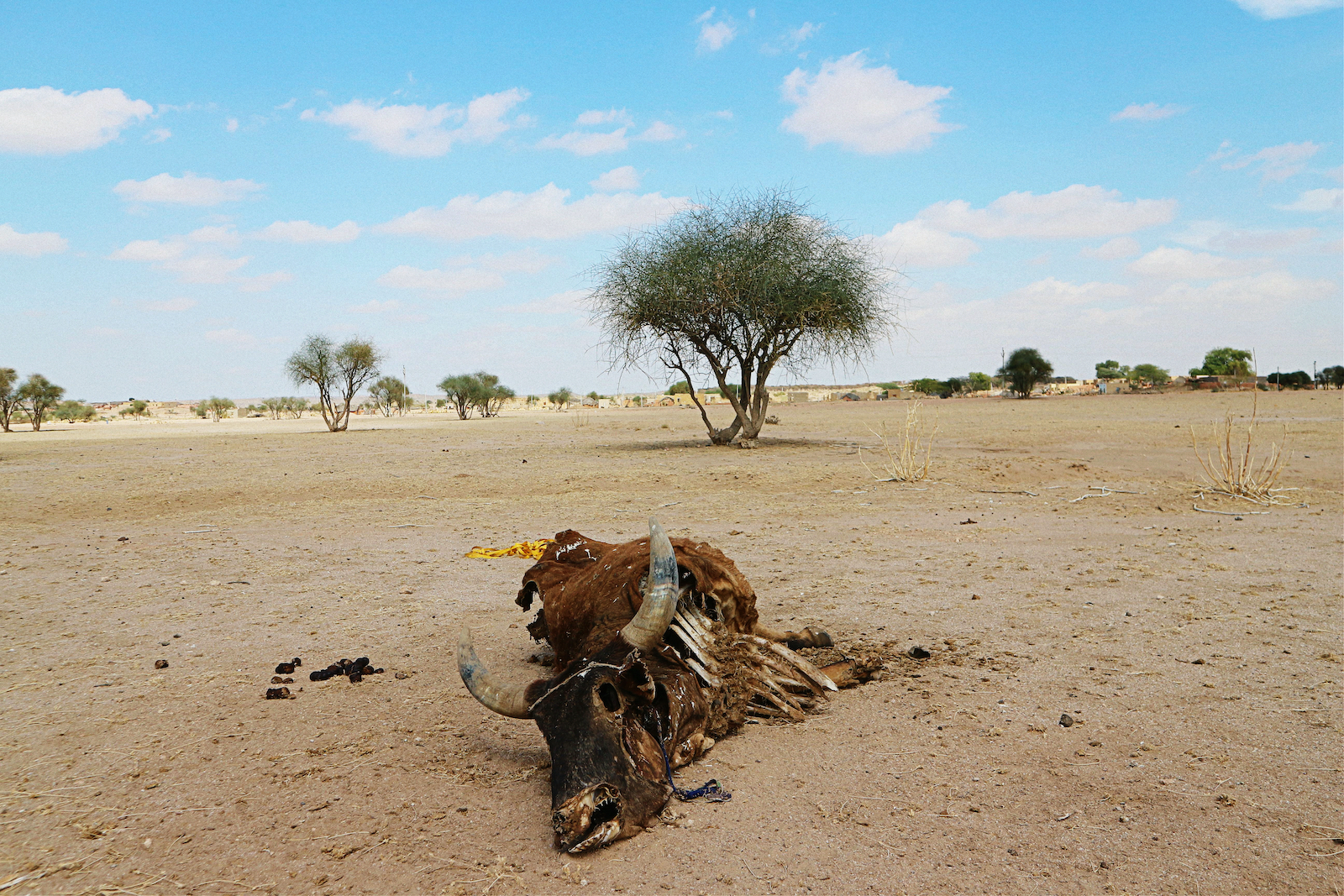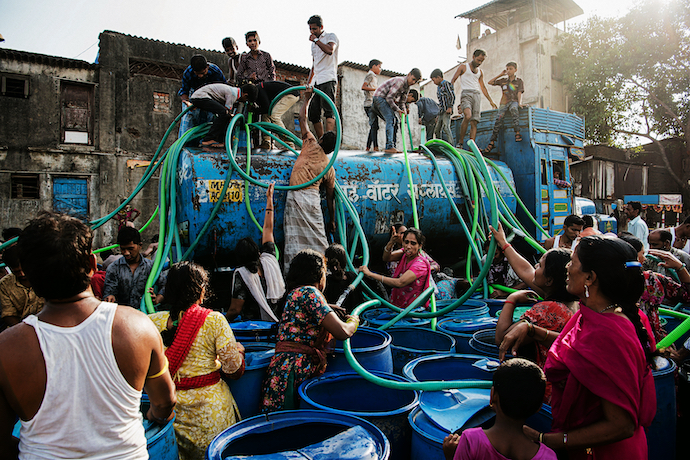
Climate Change Sets its Sights on India
NEW DELHI, India – India is among the countries most vulnerable to climate change. The impacts of higher temperatures, variable precipitation, and extreme weather events have already begun to diminish India’s overall economic performance, which in turn affects the lives and livelihoods of millions of poor people.
India is highly dependent on agriculture, and it has one of the highest densities of economic activity in the world. Very large numbers of India’s poor rely on the country’s natural resource base for their livelihoods, with a high dependence on seasonal rainfall.
The growing pressure on India’s water, air, soil, and forests is now recognized as the most intense anywhere in the world. One of the significant ways that climate change impacts the country is through water resources. While water sustains life, it all too often wreaks havoc through devastating floods and droughts. A changing climate only aggravates these shocks.
India is one of the fastest growing economies in the world, ranked among the top 10 highest GDP countries, and is the world’s second most populous country. During the past two decades, India’s GDP grew at an average of 7% annually. From 2005 to 2010, poverty declined on average by 1.5 percentage points per year — and improvements in key development indicators have been remarkable. However, following years of impressive economic growth and poverty alleviation, India is now at a critical juncture on its path toward becoming an economic powerhouse.
Climate change is actively impeding India’s development in the broader economy and in agriculture. As a result, the government, and its partners (such as the Asian Development Bank and the World Bank) are pushing for an increase in investment in adaptation measures to reduce vulnerability which will be essential to maintaining economic growth.
India’s rapid growth has increased its prominence on the global stage and drawn attention to its climate mitigation and adaptation efforts. The country has shown leadership in global efforts to limit climate change and is among the early countries to have ratified the Paris Agreement.

Scientists and researchers project that a 2.5 to 4.9 degrees Celsius increase in temperature across the country could lead to a decrease of 41% to 52% in the wheat yield, and 32% to 40% in rice.
Analyses of the country’s historic climate data support the extent of the change taking place: an increase in mean annual temperature (0.56°C between 1901 and 2007), as well as a decrease in seasonal mean rainfall with more frequent extreme rainfall events. Temperatures are projected to increase further and at a faster rate than before (1.7° to 2.0°C by the 2030s), coupled with an overall increase in monsoon rainfall (with an increase in geographic variability) and extreme precipitation events (with an increase in rainfall intensity).
India shows an increasing trend in its per capita emission of greenhouse gases, or GHG, though current per capita levels are still among the lowest in the world (2.44 tCO2 equivalent per capita in 2012, against the global average of 5.5 tCO2 equivalent). In absolute terms, India remains one of the largest GHG emitters, with its agriculture sector the second-largest contributor at around 18% of the country’s total GHG emissions.
Business and government both understand that agriculture sector growth is essential in achieving India’s development goals. The sector currently accounts for 14% of the national GDP and is a source of livelihood for more than half of the population. More than two-thirds of the country’s poor live in rural areas, and their chance of getting out of poverty directly depends on the performance of agriculture and allied rural sectors.
The success of ongoing massive rural-urban transformation will also depend on improved connectivity of rural areas to cities, enhanced agriculture productivity, value chains for agricultural products, and off-farm job creation in rural areas, which would temper down current massive migrations to urban areas. The agriculture sector also has major potential for reducing GHG emissions and improving environmental management through enhanced soil and water conservation and climate-resilient farm management practices.
Wheat and rice output threatened
Over the past two decades, the agriculture sector has performed below its potential and has not yet met the envisaged growth targets. In the 1990s and 2000s, the annual agriculture growth rate was around 3% to 3.5%, and dropped even below 2% per annum during 2013-15, due to low productivity, growing water and land scarcity, rising labor costs, and declining international commodity prices, exacerbated by the late onset of monsoon rainfall and increased rainfall intensity.
India is the world’s second-largest wheat producer and also ranks second in annual rice output. Scientists and researchers project that a 2.5° to 4.9°C increase in temperature across the country could lead to a decrease of 41% to 52% in the wheat yield, and 32% to 40% in rice.
While overall rainfall is projected to increase, its distribution over time and space will likely become much more erratic, leading to increasingly frequent droughts and floods. Unless significant efforts to capitalize on the projected increase in rainfall are made to improve water conservation and soil moisture management, water scarcity at the farm level will remain a key impediment to achieving higher levels of crop and water productivity.

Going forward, five interrelated and strategic shifts are required to achieve the 4% annual growth target set by the national government for agriculture and transform the sector into a modern food system.
First, shifting away from food grain production targets toward diversification into high-value horticulture and livestock products. Second, shifting away from a pure focus on physical productivity (yields) toward resilience and stability of agriculture to deal with the effects of climate change and short-term weather anomalies. Third, shifting away from a focus on on-farm production toward value addition in the post-harvest segments of the food value chains. Forth, shifting away from a calorie-focused production structure toward nutrition-sensitive agriculture. Finally, shifting away from increasing irrigation water supply toward improved water use efficiency.
Maharashtra project
To better understand the situation on the ground, consider the new $600 million project that aims to “enhance climate-resilience and profitability of smallholder farming systems” in selected districts within Maharashtra, India’s second-most populous state. Maharashtra is one of the country’s undisputed economic growth engines: it is the top-ranked state in terms of contribution to the national GDP and has witnessed an average economic growth rate of over 8% per annum over the last decade. With 9.3% of the country’s population and 9.4% of the country’s geographic area, Maharashtra is also the second-largest state in India.
The agriculture sector remains central to Maharashtra’s economic and political landscape, and growth in the sector is critical for the state — since more than 50% of its 125 million people depend directly upon agriculture as their livelihood.
In Maharashtra, agriculture has grown at an annual average of 6.4%, but growth in the sector fluctuates significantly and it heavily depends on highly erratic rainfall during any particular year and rainfall variability over time. The distribution of rainfall is highly uneven within the state and ranges from over 4,000 millimeters per annum in coastal areas to less than 400 millimeters in some of the aridest districts. Agriculture remains the highest user of freshwater, withdrawing more than 80% of the surface and groundwater available to the state.
Since the continuation of the state’s strong economic growth performance would have to be supported by higher water availability in all three sectors of the economy, there is a need for Maharashtra to manage its water resources better and in particular to enhance the efficiency of the water used for agriculture and focus on increasing the availability and use by the agriculture sector of rainwater stored in the soil as soil moisture. Severe consecutive droughts experienced in large parts of Maharashtra over the last two years have considerably affected the state’s agricultural performance and social fabric in rural areas. It has prompted the local government to declare “drought-proofing” a key development priority.
Maharashtra’s agriculture is dominated by small and marginal farmers with an average farm size of 1.44 hectares. Most of the agricultural production is rain-fed, with less than 20% of the arable land under irrigation. Farmers’ annual production covers two seasons: kharif crops planted at the onset of the monsoon rainfall and winter crops. These “rabi” crops are planted at the beginning of the winter season, and harvested in the springtime. Due to the broad range of agro-climatic zones and soil types encountered, the state’s agricultural production is fairly diverse. Crop production is dominated by food grains. Those are cereals (mostly rice, sorghum or jowar, maize) and pulses (chickpea or gram, pigeon pea or tur). For oilseed crops, soybean remains by far the most important commodity.
The area under cultivation for cereals has declined since 2000, with a considerable drop in the production of sorghum (though naturally better adapted to dryer conditions than other cereals) and a shift from food grains toward cash crops has been observed, with an increase in the area for cotton and sugarcane. Since 2000, an upsurge in the production of high-value horticulture crops has been observed, and today, Maharashtra has emerged as one of the country’s largest producers of fruits and vegetables.
Overall, crop productivity has increased over time but remains relatively low. One study examined these numbers in 2013-14, which was a non-drought year: sorghum 814 kg/hectare; soybeans 1,214 kg/hectare; cotton 361 kg/hectare. Yield gaps for several key crops are still significant, reflecting the need for a mix of sector policies and investments to promote research on climate-adapted varieties, irrigation for a more efficient on-farm use of water, and extension services for the adoption of climate-resilient agronomic practices and technologies — for building climate resilience in Maharashtra’s farming systems.
In 2008, India released the “National Action Plan on Climate Change” (NAPCC) and directed each of the 28 states and 8 union territories to develop “State Action Plans on Climate Change” guided by and consistent with the structure and strategies of the NAPCC.
Maharashtra’s government took a pioneering step toward formulating the “Maharashtra State Adaptation Action Plan on Climate Change” (MSAAPCC) by commissioning a comprehensive vulnerability assessment study that included the task of generating model-based climate projections specific to the state’s geography.
The MSAAPCC seeks to address the urgent need to integrate climate change concerns into the state’s overall development strategy, thus assisting in building long-term climate resilience and enabling adaptation to the likelihood of risks arising from climate change. The MSAAPCC climate modeling results for 2030, 2050, and 2070, show that temperature and rainfall are projected to increase across Maharashtra, with important regional variations — resulting, on balance, in potentially significant adverse impacts on agriculture performance.
Maharashtra’s annual mean temperature is projected to increase by around 1.3° to 1.5°C by the 2030s. The projected increase in monsoon rainfall by the 2030s ranges from 13% to 30% across the state. The effects of longer-term climate trends on agriculture and water, effectively signaling a shift in climatic conditions, will be further aggravated by the increased frequency of extreme climate events. These already are being experienced in Maharashtra, as illustrated by the three severe droughts that hit the state over the past five years.

